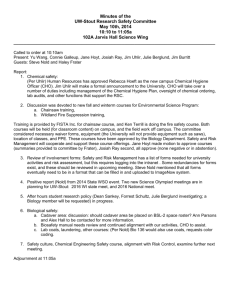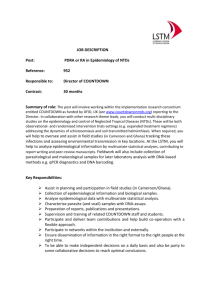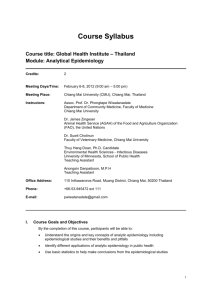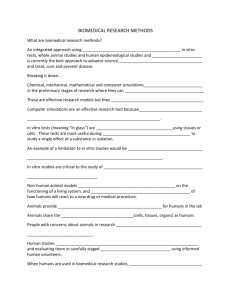Clare Oswald Stallybrass and his dispersibility ratio
advertisement
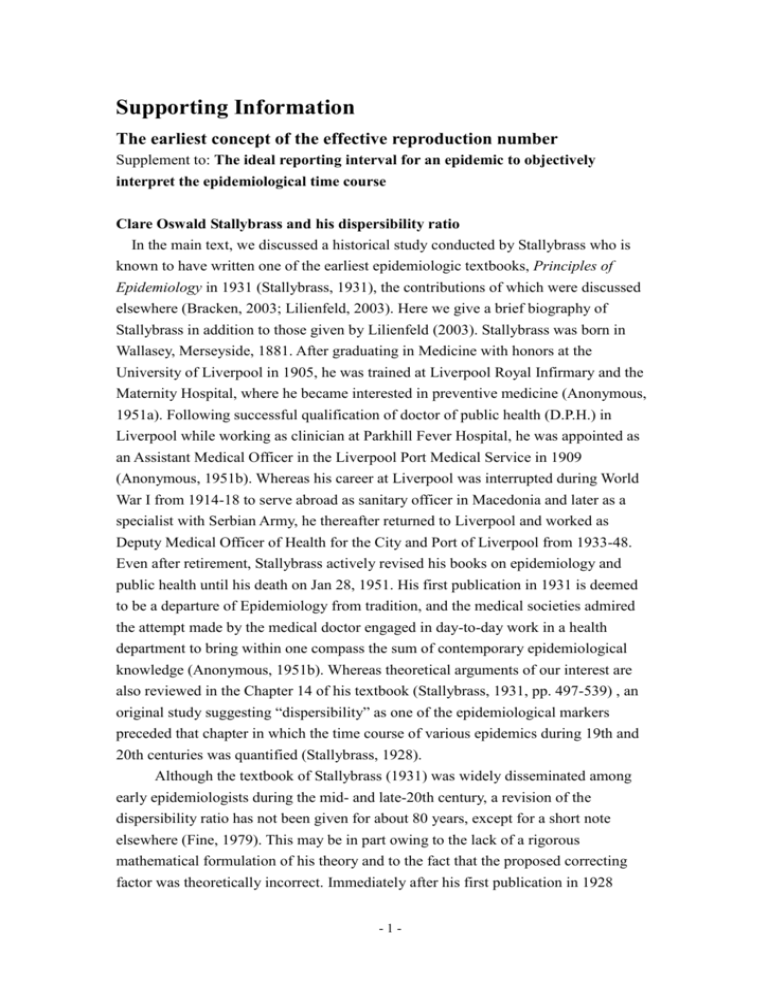
Supporting Information The earliest concept of the effective reproduction number Supplement to: The ideal reporting interval for an epidemic to objectively interpret the epidemiological time course Clare Oswald Stallybrass and his dispersibility ratio In the main text, we discussed a historical study conducted by Stallybrass who is known to have written one of the earliest epidemiologic textbooks, Principles of Epidemiology in 1931 (Stallybrass, 1931), the contributions of which were discussed elsewhere (Bracken, 2003; Lilienfeld, 2003). Here we give a brief biography of Stallybrass in addition to those given by Lilienfeld (2003). Stallybrass was born in Wallasey, Merseyside, 1881. After graduating in Medicine with honors at the University of Liverpool in 1905, he was trained at Liverpool Royal Infirmary and the Maternity Hospital, where he became interested in preventive medicine (Anonymous, 1951a). Following successful qualification of doctor of public health (D.P.H.) in Liverpool while working as clinician at Parkhill Fever Hospital, he was appointed as an Assistant Medical Officer in the Liverpool Port Medical Service in 1909 (Anonymous, 1951b). Whereas his career at Liverpool was interrupted during World War I from 1914-18 to serve abroad as sanitary officer in Macedonia and later as a specialist with Serbian Army, he thereafter returned to Liverpool and worked as Deputy Medical Officer of Health for the City and Port of Liverpool from 1933-48. Even after retirement, Stallybrass actively revised his books on epidemiology and public health until his death on Jan 28, 1951. His first publication in 1931 is deemed to be a departure of Epidemiology from tradition, and the medical societies admired the attempt made by the medical doctor engaged in day-to-day work in a health department to bring within one compass the sum of contemporary epidemiological knowledge (Anonymous, 1951b). Whereas theoretical arguments of our interest are also reviewed in the Chapter 14 of his textbook (Stallybrass, 1931, pp. 497-539) , an original study suggesting “dispersibility” as one of the epidemiological markers preceded that chapter in which the time course of various epidemics during 19th and 20th centuries was quantified (Stallybrass, 1928). Although the textbook of Stallybrass (1931) was widely disseminated among early epidemiologists during the mid- and late-20th century, a revision of the dispersibility ratio has not been given for about 80 years, except for a short note elsewhere (Fine, 1979). This may be in part owing to the lack of a rigorous mathematical formulation of his theory and to the fact that the proposed correcting factor was theoretically incorrect. Immediately after his first publication in 1928 -1- (Stallybrass, 1928), the crude measure (i.e. equation (1) in the main text) was criticized for not allowing the comparison of ratios obtained for different diseases (Stocks and Karn, 1928). Although he intended to make an adjustment of the dispersibility ratio by using a correction ratio of the reporting interval to incubation period, the denominator of which may have been assumed to reflect the epidemiological characteristics of the disease, no reason was given as to why the incubation period was used as the denominator. Many epidemiologists traditionally assumed (incorrectly) that the incubation period, at least roughly, reflected the interval between successive generations of cases (Sartwell, 1966; Fine, 2003). Moreover, whereas he suggested that it is possible to roughly assess the time course of an epidemic from the relative change of dispersibility ratios with respect to time, at least, in the successive reporting intervals, his arguments were missing an epidemiological interpretation of the absolute value of the ratio. The average infectee number of Annet Nold Nold (1979) defined the same dispersibility concept using more explicit notation, which was most likely independent of the idea of Stallybrass. By taking the ratio of infected individuals during the time interval (t1, t2), Nold referred to the quantity as the “average infectee number” of an infectious disease, (t1, t2). In contrast to Stallybrass, she clearly defined the generation time of a disease, which was originally referred to as the “average transmission time” (Nold, 1979). Whereas the main research interest of Nold was focused on a critical level (i.e. threshold condition) of transmission in an endemic state where the infectee number becomes close to 1, she also documented Rt using the mean generation time, , as a special case of the average infectee number: R (t) C(t,t ) C(t ,t) (1) where C(t1, t2) denotes the number of cases observed during the time interval between t1 and t2. R(t) was originally referred to as “incidence ratio”, and she found that the incidence trend is downward (respectively, upward) on an interval (t-, t+) when R(t) < 1 (respectively, R(t) > 1). It should be noted that equation (1) implicitly assumes that the generation-time distribution g() of length is given by a delta function (i.e. g() equals 1 if = and 0 otherwise). References Anonymous. 1951a. Clare Oswald Stallybrass, M.D. (Lond. and Liv.), D.P.H. Public Health. 64, 104. Anonymous. 1951b. Clare Oswald Stallybrass. Lancet. 1(6651), 415-416. -2- Bracken MB. 2003. The first epidemiologic text. Am J Epidemiol. 157, 855-856. Fine PEM. 1979. John Brownlee and the measurement of infectiousness: An historical study in epidemic theory. J R Stat Soc Ser A. 142, 347-362. Fine PE. 2003. The interval between successive cases of an infectious disease. Am J Epidemiol. 158, 1039-1047. Lilienfeld DE. 2003. The first epidemiology textbook, revisited. Am J Epidemiol. 157, 856-867. Nold A. 1979. The infectee number at equilibrium for a communicable disease. Math Biosci. 46, 131-138. Sartwell PE. 1966. The incubation period and the dynamics of infectious disease. Am J Epidemiol. 83, 204-206. Stallybrass CO. 1928. Season and disease. Proc R Soc Med (Section of Epidemiology and State Medicine). 21, 1185-1209. Stallybrass CO. 1931. The Principles of Epidemiology and The Process of Infection. London: George Routledge & Son, Ltd. Stocks P, Karn MN. 1928. A study of the epidemiology of measles. Ann Eugenics. 3, 361-391. -3-


